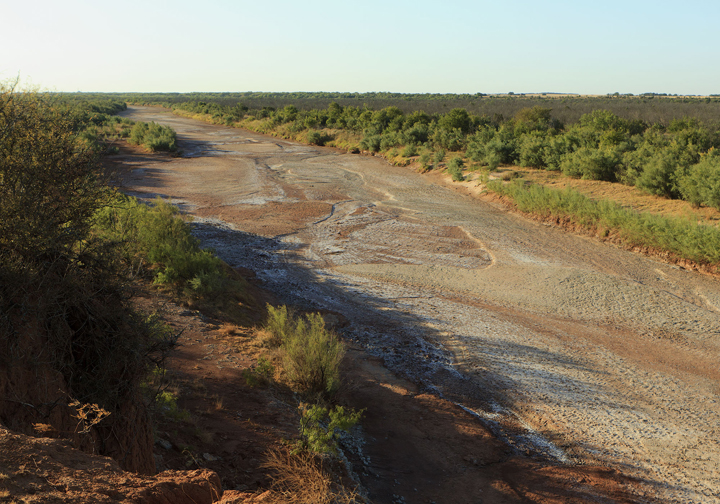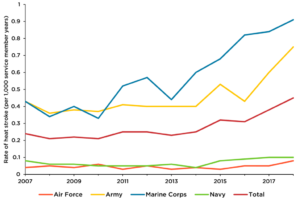 Photo by Earl Nottingham - Texas Parks & Wildlife Department
Photo by Earl Nottingham - Texas Parks & Wildlife Department
Dangers of Increasing Heat and Drought on U.S. Security
In August, 14,000 scientists from around the world called for urgent action to restore nature and decarbonize the economy to avoid reaching an irreversible climate tipping point. They highlighted an “unprecedented surge” in climate-related disasters including record-breaking heatwaves and wildfires in the US, and an uptick in devastating floods and hurricanes throughout the globe. Severe weather events like extreme heat, drought, and wildfires will become more frequent, posing grave threats to U.S. national security. The United States must increase its resilience to severe heat and drought due to the threats it poses to the American economy, food and water supplies, and military training and preparedness.
Security Threats Posed by Extreme Weather
The western United States has been in the news this summer for severe drought. Some experts have referred to this as a “megadrought” with extreme dryness that could last for decades. Prolonged drought in the west and throughout the country will strain the United States’ water infrastructure. For the first time ever, on August 16, 2021, the U.S. government declared a water shortage on the Colorado River, which affects more than 40 million people in seven states who rely on the river for drinking water and farming. The shortage declaration will reduce Arizona’s access to the Colorado River by 20 percent.
Increased drought limits a farmer’s ability to maintain water-intensive crops. Changes in local temperatures and weather conditions affect how suited crop varieties and livestock are for a region and which pests, pathogens, and weeds will thrive. Extreme drought and heat in the Western US caused $4.5b in agricultural losses in 2020 and a total of $138.3b since 2000. According to a U.S. Department of Agriculture (USDA) report, not only does climate change threaten agricultural production, it also poses risks to national and global food security by hampering agricultural processing, storage, transportation, and food consumption.
Additionally, dwindling supplies are affecting farmer’s access to water. This month, California reduced the amount of water that farmers in the state are permitted to draw from its largest rivers. The state’s $50 billion agriculture industry supplies over 25% of the nation’s food, over a third of U.S. vegetables and two-thirds of its fruit. The drought will likely make products like almonds, avocados, and milk more expensive. Though farmers can switch to crops which require less water, about 40% of the 24.6 million acres of farmland in California still require irrigation.
As explored in ASP’s Military Resilience website, climate change and extreme weather will negatively impact the readiness and resilience of the US military. Increasing temperatures and droughts are linked to an increase in heat-related illnesses among US troops at home and abroad. As shown below, there is a significant increase in the rate of heat strokes in the last decade, particularly in the U.S. Army and Marine Corps. In early 2021, the US military felt the effects of rising temperatures and droughts as wildfires spread across the Western US. The time and resources spent responding to domestic crises related to deadly heat and wildfires negatively affects its ability to respond to other needs around the world.

The rate of heatstroke among service people. Source: Union of Concerned Scientists
Strengthening American Resilience to Weather the Storm
Policymakers will need to take swift and decisive action to prepare for threats extreme weather poses to national security. The infrastructure bill is an important first step toward investing in climate resilient infrastructure for water, food and the military. Additional legislation, funding, and coordination will be needed during the next decade to safeguard U.S. water supplies and adapt to dwindling resources. For example, the current bill includes $8.3 billion in funds dedicated to water projects including water storage and recycling, drought planning, desalination technology, and dam safety. However, a coalition of water and agriculture groups have estimated that it will take at least $14 billion during the next 10 years to secure Western water supplies and reduce the chance of water conflicts between states and their residents.
As a next step, Biden could issue an executive order to permanently establish the “Water Subcabinet,” an inter-agency group formed by the Trump Administration in October 2020. The group can help states incentivize and invest in new technologies for water conservation and sustainable farming. It could also facilitate stakeholder input to help states and local officials negotiate water access as water supplies dwindle. In January 2021, the subcabinet released its Strategy and Recommendations for Modernizing America’s Water Resource Management and Water Infrastructure.
In the face of growing drought, California farmers are trying to leverage technology to avoid disruptions in the food supply chain. Growers of water intensive crops like almonds and strawberries have shifted away from flood irrigation methods to micro and drip irrigation that delivers water directly to the root systems, reducing evaporation rates. Such innovations will help farmers continue in the face of a dwindling water supply and can be further bolstered by USDA research and funding.
Finally, the US needs to address the root of the problem by achieving net zero emissions. In the lead up to the UN Climate Change Conference of the Parties in Glasgow in November, the United States must continue to take action to limit global temperature increases to 1.5 degrees Celsius and fulfil the commitments made under the Paris Agreement. Bold US leadership and action is needed to avoid a climate catastrophe and prevent future security threats from extreme weather.





